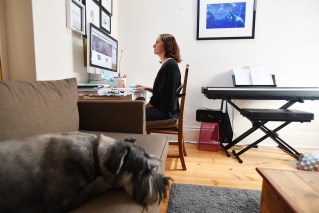Why Aussie employers need to let us work more from home


Workers now spend on average 4.5 hours a week getting to and from work – a rise of 23 per cent since 2002. Photo: Getty
People are spending longer commuting to and from work.
And that is making us less happy, less productive and less willing to stay in the same job.
According to the latest Household, Income and Labour Dynamics in Australia (HILDA) survey, workers now spend on average 4.5 hours a week getting to and from work – a rise of 23 per cent since 2002.
Sydneysiders, the survey found, spend an average of 71 minutes a day getting to and from work.
Assistant professor Libby Sander, of Bond University’s Business School, said long commute times affected not only our productivity, but also our health and wellbeing, relationships and our ability to participate in social activities.
“There’s a huge range of factors that could be alleviated by people not having to commute to work each day,” Professor Sander said.
Not to mention employers benefiting from increased productivity, lower turnover and lower office overheads.
A 2010 study suggested the Australian economy could save from $1.4 billion to $1.9 billion a year if 10 per cent of the workforce “teleworked” half the time.
The HILDA data also coincided with a survey of almost 11,000 employees by global recruitment firm Randstad in which respondents overwhelmingly nominated “work-life balance” as the most important factor when choosing an employer, staying in or leaving a job.
Randstad’s general manager of diversity and inclusion Kerry McQuillan told The New Daily that up until the past two surveys, employees routinely rated salary and benefits the highest.
But workers today are more willing to trade those away for greater work-life balance.
And much of that work-life balance could be achieved through greater workplace flexibility, namely the ability to work more from home.
“A clear solution to these commuting stresses is for business leaders to offer employees the opportunity to work flexibly, or from home to improve their happiness factor,” Ms McQuillan said.
“To attract different people, employers have to be more flexible in how those people work for you.
“We need to listen up and do more to retain good employees by delivering the trifecta of work-life balance: Flexibility, long-term job security and a competitive salary.”
Ms McQuillan said that could be different start times, working from home or establishing regional hubs from which people can work.
For example, a Brisbane company that sets up a Sunshine Coast office to avoid either a long train commute or a drive down the Bruce Highway.
So why don’t we just do it?
Three things are holding Australia back from implementing more work from home: Trust, workplace cohesion and … loneliness.
Ms McQuillan said many managers were from a generation used to working differently and more comfortable being able to observe people in the workplace.
That clashes with younger generations who simply expect more flexible work arrangements.
Social researcher Mark McCrindle agrees, saying one of the biggest blockages was a lack of trust, and that Australia had been slow to innovate and implement greater workplace flexibility.
“Many in management are still sceptical about the productivity of having people working from home,” Mr McCrindle told The New Daily.
“We have a kind of residual, authoritarian leadership style, whereby people are need to be in situ and have people observing staff in the workplace … a bit of an old-school mindset.”
But, he noted, with the average age of the Australian worker at 38, that mindset was bound to change, as Gen Y migrated into senior management roles.
But Professor Sander said one of the biggest challenges wasn’t necessarily employers, but employees.
People still need the social cohesion and peer engagement of a workplace, and – if working as part of a team – need greater face-to-face contact to feel part of that team.
“Yes, people working from home all the time are more productive, but lots of them choose not to because they get lonely, and feel they can be overlooked for promotions [because they aren’t as present], for example,” Professor Sander said.
“Virtual teams don’t perform as well as face-to-face teams also, so you need to balance where people can work from, or from co-working spaces, so people can have the best of both worlds.”
In 2013, for example, Yahoo chief executive Marissa Mayer banned working from home.
“To become the absolute best place to work, communication and collaboration will be important, so we need to be working side by side. That is why it is critical that we are all present in our offices,” she said at the time.
Professor Sander concluded there was “no one-size-fits-all”, and that employers needed at the least to offer the option of flexible work arrangements, then assess who is better suited to which environment.








